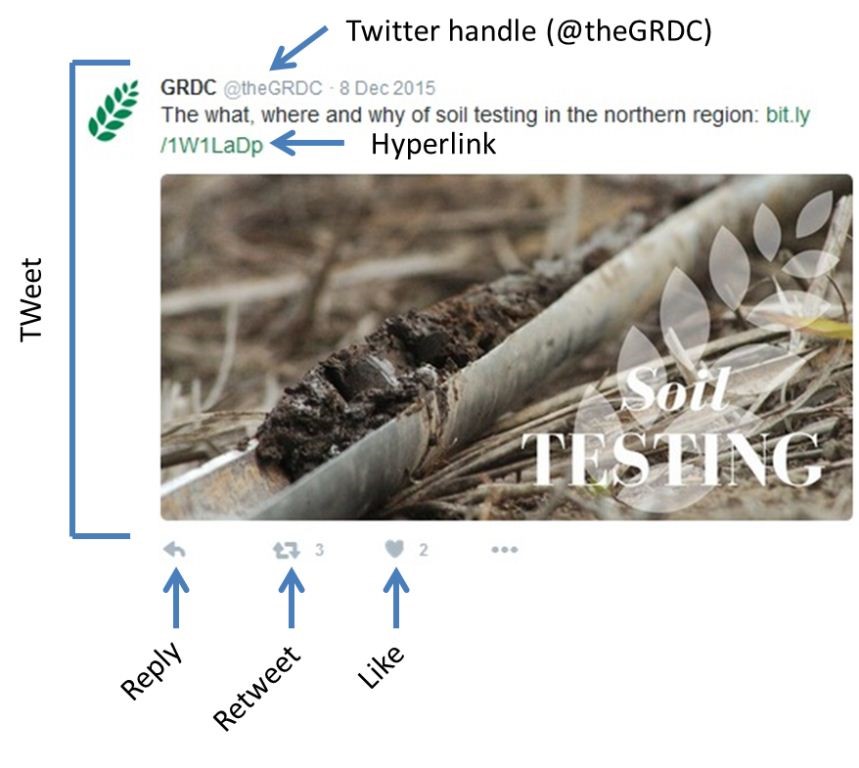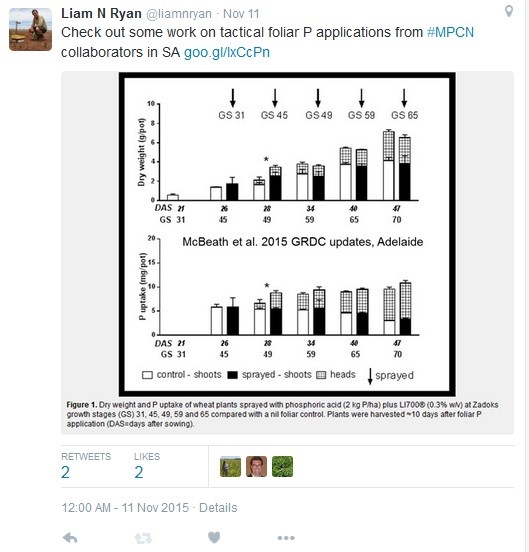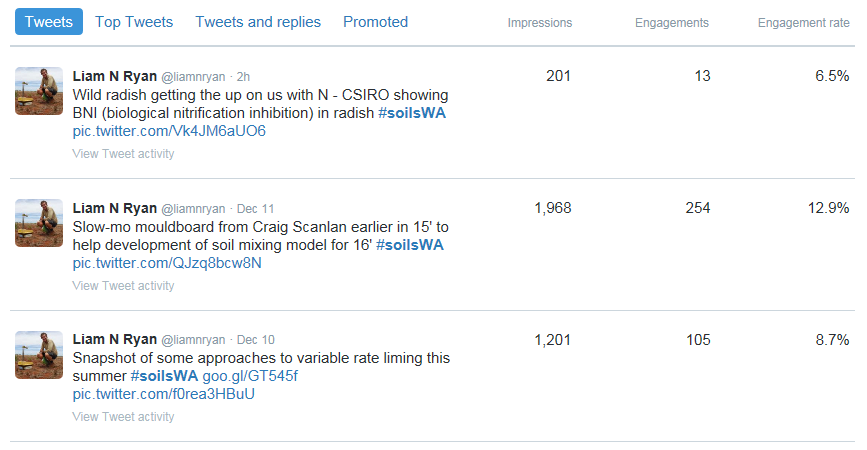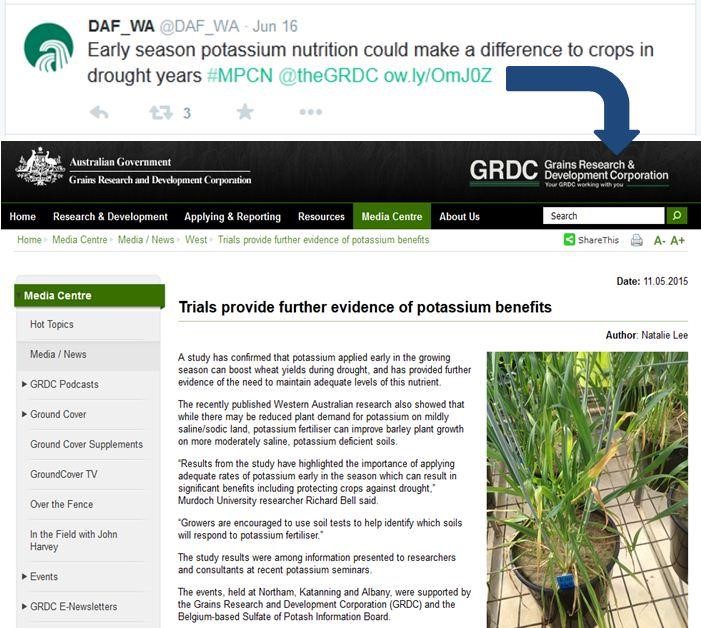Leveraging Twitter for better engagement with research outcomes
Author: Liam Ryan, Bryton McShane and Bindi Isbister, Department of Agriculture and Food, Western Australia | Date: 01 Mar 2016
Key messages
Twitter enables timely sharing of trial data throughout the season and better engagement with research outcomes
Trial data and key research outcomes were engaged with by grain growers, advisors and researchers throughout Australia over 1800 times, all for about one day’s work
Twitter helps overcome the challenges with extension in the Grains industry where growers, advisors and researchers are time-poor and geographically isolated
Aims
Investigate the efficacy and impact of sharing trial data through Twitter with grain growers and advisors. Specifically, to determine a) how widely trial data could be extended through Twitter and b) the level of interest that growers, advisors and industry representatives have in engaging with and sharing that data through their own networks.
Method
From June 2015 to November 2015 a total of 36 tweets pertaining to technical aspects of crop nutrition and/or soil management were published through the @DAF_WA (Department of Agriculture and Food, WA) handle, @theGRDC (Grains Research and Development Corporation) and @AuCropNutrition (eXtension AUS crop nutrition) twitter handles. Twitter analytics were compiled on each of these tweets, most of which were published from the @DAF_WA handle. Analytics were compiled separately for a short series of tweets from the individual Twitter accounts of DAFWA staff Bindi Isbister (@BindiIsbister) and Liam Ryan (@liamnryan). Audience demographics can be analysed in depth using a variety of tools, but for simplicity we assumed that Twitter users engaging with technical content on crop nutrition/soil management were grain growers, advisors, researchers or others involved at the farm-gate level.
Results
Background to twitter usage and twitter analytics
Twitter, now in its 10th year, is a social media platform used by an increasing number of grain growers, researchers, agricultural service providers and industry representatives. While Twitter has a reputation for social banter, the grains industry has championed the technology as a platform for high-level industry conversations, without being restricted by geographical boundaries. The text in a tweet is limited to 140 characters meaning any information shared has to be short, sharp, informative and to the point. Nevertheless, a tweet still allows for embedded media such as a hyperlink, picture or video. A typical tweet layout is depicted in Figure 1.


Figure 1 The anatomy of a tweet (left) and an example of embedding trial data in a tweet (right).
Growers regularly take to Twitter to compare farming systems, get help identifying causes of crop damage, troubleshoot machinery problems, seek advice when making purchases, access market information and tap into breaking news. As demand for digital content increases and getting attendance at events gets more difficult, Twitter provides an efficient and low-cost opportunity to communicate and get engagement with research throughout the life of projects, particularly with a younger demographic. GRDC social media analytics suggests that the dominant demographic of Twitter users in the Australian grains industry is those aged 25-34.
In order to evalaute the success of your social media efforts,Twitter analytics can be gathered free of charge from the Twitter website at https://analytics.twitter.com/. The main metrics involved with twitter analytics are:
Impressions: the number of times a Twitter user sees your tweet while scrolling through their Twitter feed Engagements: when a Twitter user interacts with your tweet either by clicking on it to view it in more detail, replying or re-tweeting it or clicking on an embedded hyperlink (see Figure 2).

Figure 2 Twitter analytics generated for individual tweets, using the personal twitter account of Liam Ryan.
There are in-depth analytics available to separate the different types of engagements, the time of the day when the tweet appeared to the most people as well as other metrics. However, the number of impressions, engagements, re-tweets and URL clicks are the main indicators that can be used to evaluate how widely a tweet is disseminated and how heavily it is interacted with by industry. It could be argued that embedding key trial data into a tweeted image (see Figure 3) and then measuring the number of times people click on that image to view it in more detail is fairly robust indicator of success in terms of spreading the message. It also starts the opportunity for replies by other Twitter users around the drivers of the yield response, other trials in nearby areas and management options for soil compaction management – the same sort of conversations had in person at a field day. In similar fashion re-tweets and likes can be used as a measure of popularity and an indication of whether you’ve hit the mark in terms of identifying pertinent trial data that growers and advisors are interested in. A combination of these analytics (compiled at regular intervals) is a valuable addition to standardised workshop evaluation forms which are rarely filled out by all attendees and/or filled out correctly.
The ‘reach’ achieved through tweeting
The tweets published on crop nutrition and soil management ranged from topics such as potassium nutrition during drought years, in-season nutrient management, increases in soil carbon from organic amendments, biomass responses to different depths of ripping and other related topics. Cumulative analytics from these 36 tweets totalled 35,050 impressions, 1851 engagements, 89 re-tweets and 530 link clicks. A simple interpretation is that Twitter users were interested enough to stop, read and interact with what was being mentioned in a Tweet that discussed some aspect of crop nutrition and/or soil management in the WA Grainbelt over 1800 times. Additionally, that content was considered important enough to be re-shared (retweeted) through different Twitter networks 89 times, with 530 clicking on an embedded hyperlink to view a web page, trial report and/or supplementary data in order to investigate the topic further. Bear in mind these numbers are for a cumulative series of tweets which, in total, took only about 1 day’s work to compile, ‘tweet’ and analyse.
A false presumption some researchers have in using Twitter is that they have to spend a significant amount of time publishing content and gaining followers to obtain value from it. This is not true. Content that is clearly labelled, informative and visually descriptive will often be retweeted through to a large audience irrespective of who publishes the message. For example, the Department of Agriculture and Food, WA has a Twitter handle with 2199 followers and publishes approximately two to three tweets per day. In comparison the personal account of Liam Ryan has 245 followers and currently publishes about one tweet per week. Nevertheless the average number of impressions and engagements is higher in the @liamnryan (Table 1). This is presumably due to a greater number of re-tweets and/or retweeting by accounts with a larger following. The publisher of the tweet matters much less than the content within the tweet. Anecdotal evidence suggests that growers are actually more likely to engage with an individual researcher than with company/organisation accounts.
Table 1 Compiled Twitter analytics from technical tweets on crop nutrition and soil management published through the Department of Agriculture and Food, WA Twitter handle (n=22) and the personal twitter handle of Liam Ryan (n=10).
| @DAF_WA | @liamryan | |||||||
| Mean | SD | Highest | Lowest | Mean | SD | Highest | Lowest | |
| Impressions | 786 | 346 | 1527 | 239 | 1089 | 623 | 2313 | 185 |
| Engagements | 39 | 33 | 134 | 2 | 91 | 90 | 261 | 8 |
| Re-tweets | 3 | 2 | 9 | 0 | 5 | 4 | 13 | 1 |
| Link Clicks | 11 | 10 | 39 | 0 | 10 | 14 | 48 | 0 |
Grain yield from main treatments and sub treatments along with important information such as growing season rainfall can be embedded into a picture and published as a single tweet that encapsulates the key messages from a field trial (see Figure 3). Clear, concise Tweets structured in a similar manner are easily and often spread through a large network of grain growers, advisors and researchers. This particular tweet (Figure 3) stimulated enough conversation that it triggered a follow up article by the GRDC Science writers in the Western Region and was re-tweeted internationally. In similar fashion, a tweet published by @liamnryan which included a slow motion video of artificial sand being mouldboard ploughed as part of a soil mixing experiment, was retweeted only hours later by a precision agriculture company operating in the American Mid-West and a prominent agricultural engineer based in Quebec, Canada. Evidently Twitter could act as a tool to showcase research to an international audience and spur the exchange of ideas and potential collaborations.

Figure 3 A tweet published by @BindiIsbister on the effect of different depths of ripping on grain yield in Binnu in 2015. This particular tweet, only three weeks after, had 7249 impressions, 943 engagements, was retweeted 53 times and stimulated over 100 replies from growers, advisors and researchers regarding the trial data and related trials. It’s a testament to the effectiveness of using Twitter to extend trial data to growers and stimulate conversation over it.
Layering information to capture the whole story
The ability to layer information is important because it allows for different depths of engagement. Not every grower or advisor needs to know specific trial details to understand and implement a take home message, but there are also clear circumstances where the devil is in the detail. Layering information allows for both through a simple stand-alone message and a hyperlink leading to further information, if required (see Figure 4). A significant yield benefit from a particular treatment often warrants investigation. Access to trial reports is required to understand what drove the yield response and if a similar response is achievable on-farm, in what’s likely to be a different rainfall zone, soil type and/or farming system than the trial itself. Embedding hyperlinks to web based resources (web pages hosting electronic trial reports, fact sheets, YouTube videos, etc.) provides easy access to the resources needed to contextualise the trial outcomes such as soil tests, rotation history and plant establishment in order to make a better decision. This is especially important when a grower or advisor doesn’t have ready access to the researcher in question, can’t speak to them directly at a local field day, or alternatively, can’t find time to leave the farm to attend a pre-scheduled workshop or trials review day.

Figure 4 Schematic illustrating the link between a tweet (top) containing a short, stand-alone message and the destination of the embedded hyperlink – a technical article from GRDC summarising potassium research (bottom) which links to even further information. #MPCN is the acronym for the research program funding this particular work (More Profit from Crop Nutrition) and the funding body itself (GRDC) is tagged through their twitter handle @theGRDC.
Using twitter to generate practice change
Twitter may also be beneficial in generating practice change. The tweet depicted in Figure 3 stimulated much discussion on the addition of top-soil slotting plates to deep ripping machinery, a new concept being evaluated by DAFWA researchers under a GRDC funded soil compaction project. The manufacturers of these plates have reported an increase in the number of growers ordering topsoil slotting plates to be fitted to deep rippers this season, in addition to a number of tweets by growers regarding types of topsoil slotting plates being manufactured by the growers themselves. Furthermore, much of these discussions occurred during November and December while growers are busy harvesting and find it difficult to leave the farm. Importantly, Twitter allowed for the conversation to develop during harvest (typically a quieter period for extension) enabling growers to discuss different practicalities of deep ripping such as equipment purchase and management, plant establishment following ripper and related topics prior to implementing these practices in early autumn.
Navigating the clutter on twitter
For those already using Twitter you’ll know that it’s easy to feel overwhelmed with the vast flow of information streaming through a Twitter feed. Nevertheless there are tools such as Tweetdeck which allow you to create separate, customised twitter feeds to focus on particular people or conversations. This can allow for one Twitter feed to cater for social banter and another solely to focus on researchers sharing trial updates throughout the year. Furthermore, twitter feeds could be further customised to create a separate Twitter feed to follow a group of researchers sharing trial data on pests, weeds and diseases, and another to follow researchers sharing trial data relating to soils and fertilisers, for example. For further information, see https://tweetdeck.twitter.com/.
Conclusions
It’s increasingly difficult to share and discuss trial outcomes in person at industry events throughout the year given greater time demands on growers, advisors and researchers. Twitter is an easily accessible tool which researchers can use to share and discuss trial results with growers and advisors to help them make profitable investment decisions. It can be leveraged throughout different times of the season with minimal time requirements on both researchers and growers/advisors. Meaningful analytics from Twitter can be easily generated and compiled for monitoring and evaluation purposes and project reporting. Furthermore, conversations can go both ways on an array of trial details (follow crop agronomy and crop physiology researcher James Hunt @agronomeiste as a good example). Bear in mind that some caution needs to be taken to ensure trial data and results are properly contextualised before tweeting.
Acknowledgments
Thanks to Pru Cook (GRDC), Yvette Gaweda (NSW DPI) and Blakely Paynter (DAFWA) for the thoughtful conversations and assistance acquiring analytics data. The research undertaken as part of this project is made possible by the significant contributions of growers through both trial cooperation and the support of the GRDC, the authors would like to thank them for their continued support.
Paper reviewed by Pru Crook.
GRDC Project codes: GIA00004, DAW00223, DAW00243
®Registered trademark
GRDC Project Code: GIA00004,
Was this page helpful?
YOUR FEEDBACK
